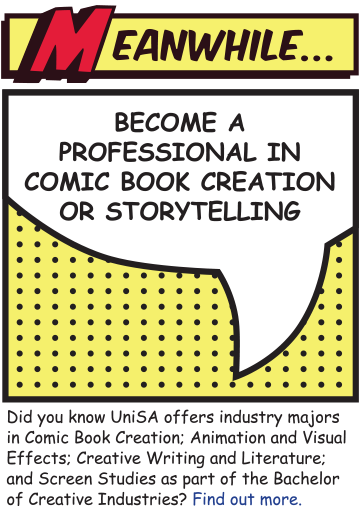25 June 2021
AUTHOR: CANDY GIBSON
Modern-day superheroes offer an escape from the brutal reality of the current pandemic. But are they much more than that?
What is it about comic books and superheroes that draws us in? In their simplest form, they are merely serialised stories, pitting good against evil, presented in panels with pictures and word bubbles.
When Phantom – the first superhero – debuted in 1936 as a mysterious, costumed, immortal crime fighter, he set the precedent for those who followed: larger than life characters, representing noble causes, having great powers and using their skills for good.
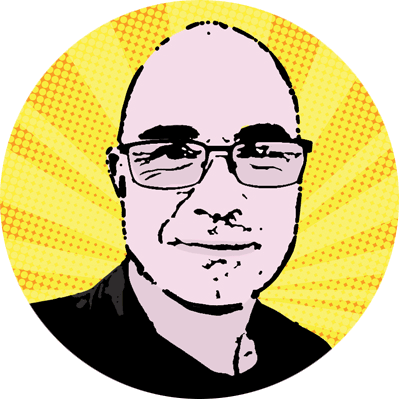
The ‘Ghost Who Walks’ was closely followed by ‘The Man of Steel’ (Superman), ‘The Caped Crusader’ (Batman) and ‘Shazam’ (Captain Marvel), within the same decade. All were idealised forms of God, according to UniSA illustrator and animator, David Blaiklock, an award-winning teacher in his field.
“Superheroes embody what we value in society at a given point in our history,” Blaiklock says.
In the 1930s, the strong, muscular, white, alpha male was championed. Today that narrative has shifted to embrace women and diversity in all its forms. One only has to look at the popularity of the comic Ms Marvel (aka Kamala Khan), a Muslim Pakistani-American teenager, to see how far society has come.
Today’s superheroes reflect different cultures, backgrounds and sexual orientations, and are less idealistic and psychologically more complex than their forebears.
“We have a broader perspective now and our approach to life is less black and white. We are also more conscious of the messages we are sending to readers, most of whom are young and forming their ideas and values,” Blaiklock says.
Blaiklock, who is Program Director for UniSA’s Bachelor of Design (Illustration and Animation), drives home to his students – the next generation of illustrators – the importance of thinking about the characters they draw and whether they fit the narrative they want to convey to society.
“If we tell them the macho superhero who degrades women is okay, then those behaviours will be endorsed. We have a responsibility to educate as well as to entertain, given the power that comics have.”
This influence was highlighted in 1954 with the publication of Seduction of the Innocent by German-American psychiatrist Fredric Wertham, who criticised overt depictions of violence, sex and drug use in crime comics, describing them as “a cause of juvenile delinquency”.
His book was taken so seriously by the US Government that it resulted in the establishment of a Comics Code Authority, a self-policing code of ethics and standards for the industry.
Although voluntary, the code was essentially a form of censorship, banning any content deemed “harmful” to children and requiring that “good shall triumph over evil” in every instance.
Specific restrictions were placed on the portrayal of kidnapping and concealed weapons, and depictions of “excessive violence” were forbidden along with sexual innuendos and “lurid, unsavoury and gruesome illustrations”.
The code sent many titles underground for years, spawning a counterculture of comic books that offered an alternative, satirical perspective on life, including drug use, sex and violence.
“The 1954 code illustrates just how much influence comics had in that era,” Blaiklock says. “Prior to new technology and the advent of television, comics wielded a lot of power over young people. They reached a huge audience and established views and social norms that carried over into adult life.”
Even today, where comics compete with many other media, authors continue to address some of society’s big issues – the environment, politics, racism, gender, diversity and poverty.
Blaiklock says Australian schools have introduced the graphic Holocaust novel, The Complete Maus, into their English curriculum, demonstrating and acknowledging that comics now stand alongside novels, plays and poetry as a literary form worthy of study.
Aboriginal stories are also being effectively told through comics, including Cleverman, which reimagines several stories of the Dreamtime in a modern, superhero context. The series is helping to rewrite the Anglo-Saxon view of Australia’s history of occupation, featuring genocide, the stolen generation, domestic violence and strong women and girls in its storylines.
Neomad is another interactive comic set in the Pilbara region of Western Australia as a community art project, equipping young Aboriginal people with a host of new digital skills. The three-episode series, which meshes thousands of years of traditional Aboriginal culture with futuristic, sci-fi adventure, has picked up prestigious awards along the way.
The rise of diverse heroes
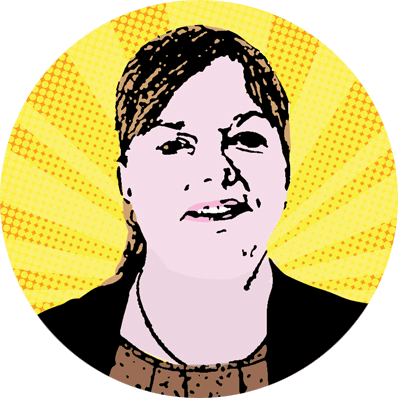
UniSA visual storytelling lecturer Dr Jeanne-Marie Viljoen, who coordinates an Introduction to Comic Books elective, says alternative comics have led the way in introducing more diverse heroes.
“Love and Rockets produced by the Hernandez brothers in the 1980s, based on a fictional village in Latin America, is a good example, particularly in their depiction of racial minorities in a very realistic way,” Dr Viljoen says.
By contrast, Marvel’s treatment of Alpha Flight gay superhero Northstar is more tokenistic, she argues.
“Mainstream comics, largely written for straight, white American audiences, include just enough of these ‘other’/minority characters in their narratives to drive profits, rather than confronting these qualities in a more complex way,” Dr Viljoen says.
“There is a whole world out there of comics in countries other than the United States which do not present people in the same neat binaries that we are used to seeing in the west.”
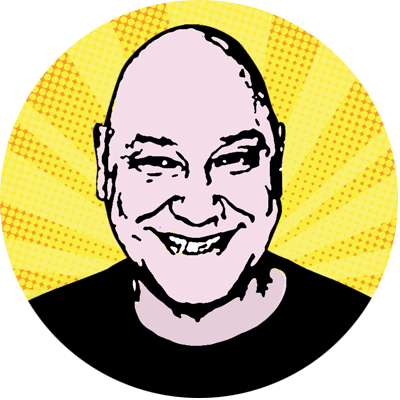
UniSA Media Arts instructor Dave de Vries, who has worked for both Marvel and DC, says that given the historic demographic of their readerships, it is not surprising that issues focusing on minorities are not usually the central component of the US publishers’ storylines.
“Both Marvel and DC are unashamedly mainstream with New York sensibilities. They need to appeal to the largest common denominator to make a quid,” de Vries says. “If they believed that Superman as Arabic, gay or black was going to increase sales, then they wouldn’t hesitate ... the model as it stands is earning them money.
“The mainstream comics are probably the least well suited to trying to push diversity. They tend to leave that to the independent publishers who are very good at writing content that is more nuanced when it comes to gender and diversity.”
That said, de Vries says Marvel introduced female characters from the outset, as well as bringing other cultures into their narratives and people with disabilities (Professor X, Daredevil and Doctor Strange to name three).
He rejects the view that comics are highly influential within the broader society or shape public opinion or behaviour to any great extent.
“The content of Japanese comics, for example, is far more explicit and violent than in the western world but their crime rate does not reflect that. It is a very peaceful society. In fact, there is an argument that comics are quite like the circuses of ancient Rome. When you give people an opportunity to free their dark side in a safe and controlled way, they are less likely to act out these impulses in their day-to-day lives.”
The evolution of the superhero
The superhero genre has gone through several evolutions in the past 80 years, de Vries says, morphing from protagonists focused on “truth, justice and the American way” to more complex characters motivated by forces other than just “protecting and serving”.
“I created a superhero who was motivated by money, which goes against the grain of the traditional superhero who has unselfish motives. When I created my protagonists there was no great desire to set up champions that people could aspire to; it was more a case of creating an interesting storyline. I have a suspicion that most writers in this genre today are more focused on the storyline than an aspirational model,” de Vries says.

The increasing spending power of women and their demand for more feminist role models is also reflected in today’s superheroes, according to UniSA Professor of Arts and Cultural Leadership, Ruth Rentschler.
Ms Marvel’s evolution from Carol Danvers (a white, former US astronaut and pilot) to Kamala Khan (a Muslim Pakistani-American teenager from New Jersey) was a game changer for the industry in 2013, embracing diversity, race and religion in the storyline.
“Comics have made changes in line with the shift in social consciousness,” Prof Rentschler says. “Feminism has spawned a whole range of Marvel female superheroes, including Batgirl, Black Widow, Storm and Scarlet Witch.
“This trend has crossed over to the screen, with characters like Stella Blómkvist on SBS, an Icelandic female detective who has huge appeal, with her fluid sexuality, dark past and quick wit.”
Prof Rentschler says women are still looking for a hedonistic superhero experience to transport them out of their humdrum everyday lives, but they also want authentic role models.
Curiously, the US obsession with the superhero is not mirrored in Asia, Europe or the UK.
The two most popular comic magazines in Britain’s history, The Beano and The Dandy, feature children as the protagonists; typically playing out pranks, bullying, petty crime and even celebrating flatulence – hardly the traits of superheroes.
Likewise, The Adventures of Tintin by Belgian cartoonist Georges Remi, who wrote under the pen name Hergé, was the most popular European comic of the 20th century, published in more than 70 languages with sales of more than 200 million copies. Its protagonist was a daring young reporter and his dog Snowy, straddling adventure, comedy and action.
Superheroes who save the world are not a dominant theme in Japan, either, where comics and graphic novels (manga) cover all genres, from action to adventure, business, comedy, drama, horror, sport, romance and erotica.
The origins of Manga stretch back several centuries to the 1600s. Today, Manga constitutes a $4 billion industry in Japan, cementing its influence across all age groups and every facet of society.
De Vries says it is plausible that the US has created the concept of the superhero to fill a void – the lack of mythical demi-god heroes in its own history.
“Britain has King Arthur and Robin Hood; Europe has Charlemagne, Julius Caesar, and Alexander the Great, among others. But there’s nothing particularly sexy about the founding fathers of the US,” he says.
While the appetite for comic books stems largely from nostalgia and an escape from reality, they have earned the right to be taken seriously. Their jaw-dropping commercial success, thanks to their translation into television, film and radio, is testament to their long-lasting appeal.
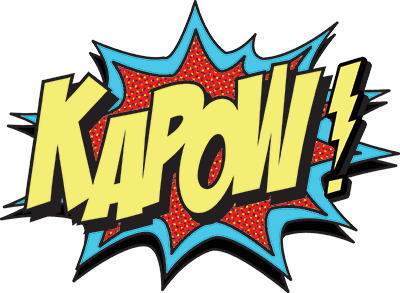
The last word goes to US filmmaker Robert Weiner, quoted in a 2017 interview: “Comics have been accused of dumbing down society, looked at as literary and artistic trash. In fact, both brain researchers and educators are finding this is not the case. Reading a comic engages your brain because you have to make inferences. So instead of making you dumber, comics can actually make you smarter.”
You can republish this article for free, online or in print, under a Creative Commons licence, provided you follow our guidelines.


